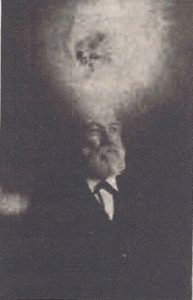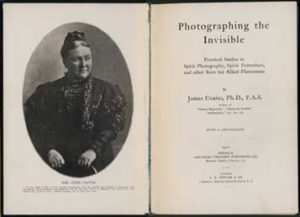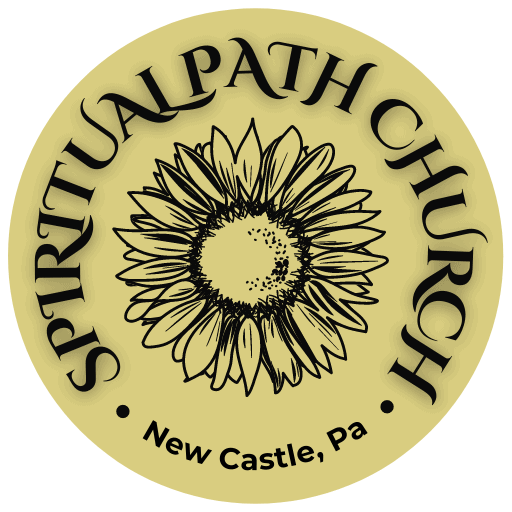Veteran Spiritualist, Andrew Glendinning, was noted for his investigations into spirit photography. During the period from 1864 to 1908, he experimented in psychic-photography with a number of friends who were mediums. He recorded his experiences with and without the presence of a medium, and published his observations in a book entitled “The Veil Lifted.”
 Glendinning related his observations obtained with Mr. James N. Anderson in the presence of Mr. David Duguid, and occasionally with his assistant. They got several pictures, including a portrait of Mr. Anderson’s little boy, who had died two years previously. “There he was in the night gown which he had worn on his death-bed, and which had been buried with his lifeless body. Yes, there he was, but with this difference, that his pleasant eyes were now seen open, and instead of the pallor of death, a happy smile was on his face…”
Glendinning related his observations obtained with Mr. James N. Anderson in the presence of Mr. David Duguid, and occasionally with his assistant. They got several pictures, including a portrait of Mr. Anderson’s little boy, who had died two years previously. “There he was in the night gown which he had worn on his death-bed, and which had been buried with his lifeless body. Yes, there he was, but with this difference, that his pleasant eyes were now seen open, and instead of the pallor of death, a happy smile was on his face…”
In another instance, Mr. Glendinning relates the story of Mr. John Dewar. Mr. Dewar went to a Mr. Boursnell’s hoping to get a picture of his mother. He received instead a portrait of his deceased sister Jeannie who was recognized by relatives and friends. To prevent fraud, Mr. Dewar took his own photographic plates with him. Mr. Boursnell also invited Mr. Dewar to examine the camera, and invited both of them into the dark room to develop the plates. Glendinning said, “I was with them in the dark room during the process of development and fixing. Others have been privileged in the same way when Mr. Boursnell felt certain that they were honest and earnest.”
Glendinning also tried capturing spirits without using a camera. In 1892, he discovered a beautiful woman twice on his own plates during the absence of a medium. He noted that there were some differences between the two in the folds of the “spirit-drapery.” A few days later the same form, with a still different arrangement of drapery was captured on stereoscopic plates by Mr. James Robertson and Glendinning. On that occasion, the medium, Mr. David Duguid, was present.
“Opponents of Spiritualism amuse me by their explanations that I must have procured a statue of ‘Clytie,’ dressed it with muslin, and photographed it to represent a spirit form,” Glendinning said. He insists that was not the case.
 Another photograph obtained without the help of a medium, was that of a “foreign-looking” lady on the same plate as himself. He was visiting one of his married daughters, and had her help expose the plate. The development and fixing were done by Glendinning.
Another photograph obtained without the help of a medium, was that of a “foreign-looking” lady on the same plate as himself. He was visiting one of his married daughters, and had her help expose the plate. The development and fixing were done by Glendinning.
Glendinning also created a series of twenty-six prints without the use of a camera. These were called Dorchagraph’s, coined by Andrew Glendinning to distinguish them from “thought photography” later known as Skotographs. One of them was a portrait of a William Haxby. Another portrait was that of Bishop William, of Wykeham, known as the Architect Bishop. “This portrait I obtained several times,” Glendinning said. “both with and without the camera, and always exactly the same. This effectually proves that the duplication of the same form with different sitters which sometimes occurs is not by any means a proof of double printing, as has been frequently alleged.”
Reference: Photographing the Invisible: Practical Studies in Spirit Photography, Spirit Portraiture, and Other Rare but Allied Phenomena. James Coates, 1910.
